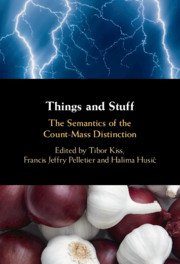Book contents
- Things and Stuff
- Things and Stuff
- Copyright page
- Dedication
- Contents
- Figures
- Tables
- Contributors and their Affiliations
- Preface
- 1 Editorial Introduction: Background to the Count–Mass Distinction
- Large-Scale Architectures for Count and Mass
- Implications from Individual Languages
- Compositional Analyses and Theoretical Issues
- 10 Ontology, Number Agreement, and the Count–Mass Distinction
- 11 The Semantics of Distributed Number
- 12 Container, Portion, and Measure Interpretations of Pseudo-Partitive Constructions
- 13 Overlap and Countability in Exoskeletal Syntax: A Best-of-Both-Worlds Approach to the Count–Mass Distinction
- New Empirical Approaches to the Semantics of the Count–Mass Distinction
- References
- Language Index
- Subject Index
10 - Ontology, Number Agreement, and the Count–Mass Distinction
from Compositional Analyses and Theoretical Issues
Published online by Cambridge University Press: 21 May 2021
- Things and Stuff
- Things and Stuff
- Copyright page
- Dedication
- Contents
- Figures
- Tables
- Contributors and their Affiliations
- Preface
- 1 Editorial Introduction: Background to the Count–Mass Distinction
- Large-Scale Architectures for Count and Mass
- Implications from Individual Languages
- Compositional Analyses and Theoretical Issues
- 10 Ontology, Number Agreement, and the Count–Mass Distinction
- 11 The Semantics of Distributed Number
- 12 Container, Portion, and Measure Interpretations of Pseudo-Partitive Constructions
- 13 Overlap and Countability in Exoskeletal Syntax: A Best-of-Both-Worlds Approach to the Count–Mass Distinction
- New Empirical Approaches to the Semantics of the Count–Mass Distinction
- References
- Language Index
- Subject Index
Summary
I discuss how syntactic and semantic theories of number interact with different accounts of the mass-count distinction as a way to figure out the relationship between number features and countability, and to give theoretical explanations of why furniture-like nouns cannot combine with numerals. I argue that certain accounts of number marking “force one’s hand” in terms of the semantic representation of mass and count NPs. “High number” theories only work if either (i) the denotations of mass NPs are necessarily disjoint from the denotations of count NPs or (ii) mass NPs are assigned a different type than count NPs. I discuss three types of semantic analyses of the mass-count distinction. One maintains two disjoint domains—one mass, the other count. Another maintains a single domain but assigns different semantic types to mass and count NPs respectively. A third maintains a single domain and a single type for all NPs but accounts for distributional differences by appealing to either syntactic features or certain denotational characteristics (join-closure, atomicity, etc.). I discuss how these three approaches interact “high number” theories and “low number” theories
- Type
- Chapter
- Information
- Things and StuffThe Semantics of the Count-Mass Distinction, pp. 237 - 260Publisher: Cambridge University PressPrint publication year: 2021



